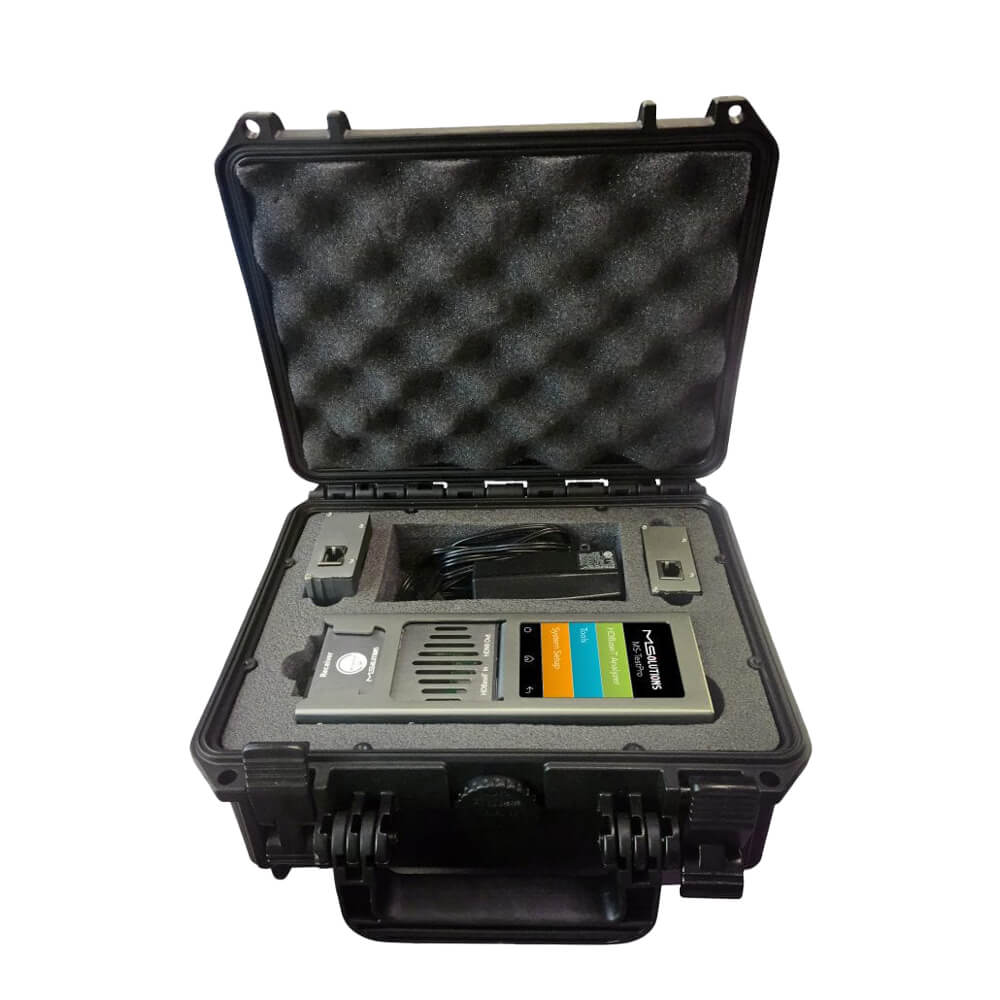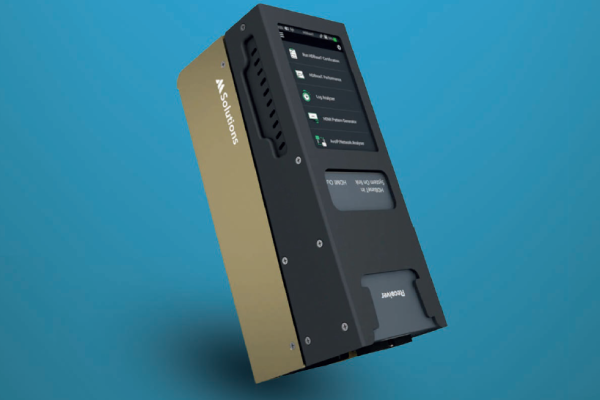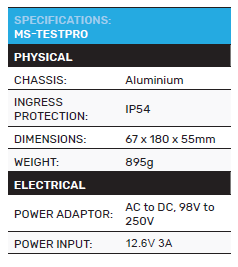MSolutions MS-TestPro
The MS-TestPro MS-104B is the only HDBaseT-certified tester that is all-inclusive, 100% reliable and portable. Myke Ireland looks into what the tool can do for AV installers and integrators.
I’ve always been fond of gadgetry, and I’m certain it came from my childhood love for Transformers, Machine Men and Voltron. To contextualise “gadgetry” within the article you’re about to read I mean anything that can do multiple things, perform multiple actions or alter its physical form to become something else.
ADVERTISEMENT
As a kid, getting a Transformer as a gift was technically getting two toys in one… Voltron was like getting six! As it turns out I don’t have any kids, but common sense would tell me as a parent, buying Transformers for a kid also makes good financial sense, naturally, you’re getting two for the price of one.
Being a fully grown man now, I just buy all my own Transformers anyway… The MS-TestPro from MSolutions is kind of a Transformer itself and I certainly had some fun with it. Let’s break it down.
Out of the box
The key standout of the MS-TestPro is how modular it is, and modular in the true sense of the word. Its physical form presents as a primary base unit housing a compute module (which I’m pretty sure is a Raspberry Pi) and the battery.
Where things get Transformers kind of cool is, in order to unlock different test capabilities, you take a little aluminium module and slide that into the din receiver within the aluminium chassis. Once connected, it unlocks a set of menu items dedicated to the functions of that specific module alone and I think that is brilliant.
It inherently stops users from having to navigate menus on top of menus only to avoid 90% of the info you don’t need. This way, users connect the right module and there are all the correct tests directly available and displayed as primary menu options on the home screen.
In the hand, the unit is heavy and robust, wrapped in stamped aluminium and clearly designed to stand up to the knocks and bumps expected in the field. Not that I was daring enough to do it, but I believe if dropped from a height of a couple of meters, it’s likely going to do more damage to the surface it collides with than the device itself.
All the external ports are easy to access, and the main chassis has a dedicated HMDI out that you can use to run a series of tests without the need for an expansion module. Tests available via the primary HDMI out include all the variable test patterns and refresh tests you’d expect, all provided in 4K and 1080p options.
Given the size of that battery and the weight of the metal chassis, it’s a relatively heavy piece of kit, so I feel like it’s going to spend most of its time on the bench. The tester is marketed as a handheld device and is portable enough to fit in hand quite well, ergonomically though that’s just not the case. It’s very likely it will fatigue your wrist after a long enough day so if you have the option to set it down in the areas where you’re doing most of your work it’ll certainly save some strain.
Most of the weight comes from the internal battery which will happily see the unit through a full day’s worth of testing, so the trade-off makes sense. If the battery happens to let you down, it can be connected to power to both charge and keep the unit operational.
Putting it to the test
The tester comes complete with a fully integrated touch-sensitive display panel to drive all the main functionality and though while big enough to drive with an index finger, the screen does get a bit crowded at times.
The unit ships with a neatly presented stylus that tucks away under the screen, but a stylus in 2023 is something that I’m still not convinced users will gravitate to. Alright, so I don’t want to be too harsh because you do need a stylus at times given how much detail there is on the relatively small display, but if there is one universal truth then let it be this; styli (which is the correct plural of stylus) always go missing, so be sure and tether it to the chassis.
If the built-in screen isn’t quite enough for you, all reports can easily be transferred to a laptop or smartphone for more viewable real estate and for simple delivery to your client post-commissioning.
There are four available expansion module kits: HDBaseT Spec 2.0, AVoIP, HDMI and then there’s a DCR Module for measuring DC Resistance of CATx cables this checks the ability to provide a sufficient level of PoE/PoH (Power-over-HDBaseT). Finally, a UCT module for the DC measurement of the internal wiring on USB Type C Cables. Tests with this module measure all USB-C features, USB2.0 (480Mbps), USB3.1 (Gen1 up to 5Gbps), USB3.1 (Gen2 up to 10Gbps), charging, monitor/laptop power, audio support as well as video and quality.
The first barrage of tests I jumped into was HDMI and let me tell you the MS-TestPro is relentlessly unforgiving. The distributor, Kordz, also imports a range of high-quality commercial cabling and was kind enough to send me three HDMI cables and one shielded Cat6 fresh in the bag. One of the HDMI cables was an Ultra High Speed HDMI (2.1) rated 48Gbs, so either 8K60 or 4K120 and it passed with flying colours, green lights all the way. However, the two alternative cables, both rated 18Gbs HMDI (2.0), failed the 18Gbs test, repeatedly. They passed as 10.2Gbs, so 40K30 in 4:2:0 but no matter how many tests I did they would not pass the HDMI 2.0 test.
Naturally, I then moved the cables to my test monitor and pumped some 4K60 4:4:4 through it, low and behold it was passing video at the full bandwidth and resolution, with no issues. Over the next couple of days, I ran a few more 18Gbs cables through the tester, to about 50/50 results. Sometimes the length of the cable had a role to play, sometimes not. I think it’s very likely that the tester has very tight tolerances and is likely addressable in future firmware updates.
It’s worth keeping in the back of your mind, however, just because your cable fails on the tester, it may not mean that it’s faulty, it’s just a really savage tester for the minute. Luckily all these little quirks can be tweaked in future firmware revisions, so if you’re listening folks… thanks in advance on that one.
Moving on to USB-C testing and every test was perfectly accurate. Bandwidth affirmation and power delivery capabilities were reported accurately on all four USB cables I tested, so the firmware is very well calibrated in that space.

The key standout of the MS-TestPro is how modular it is, right out of the box. Its physical form presents as a primary base unit housing a compute module and the battery.
The AVoIP and HDBaseT testing options are extensive, very extensive, and I simply don’t have the word limit to go full depth on those. What I will say is this, even the more complex of tests are designed to display information simply and within the context of the parameters being tested. You can deep dive further into any of the data sets that the tester provides, but its ability to present you with the info you need to know right when you need to know it certainly makes it stand out among some of the competing testing platforms.
The round out
Overall, I’m suitably impressed with the MS-TestPro and I think it’ll have a really exciting future ahead of it. The nature of its flexible software platform and the ability for MSolutions to simply create more modules as demand increases or new technologies emerge seems like a no-brainer to me.
I’d love to see a Dante module that could fetch various Dante traffic flow information from a network port, or current draw across a string of 100V speakers perhaps. The possibilities are really open to the demands of the market, and in my book, that’s where innovation starts.
If you’re looking for a jack-of-all-trades tester and one that’s smart enough to only focus on the things you want it to, then the MS-TestPro is all that and then some.
-
ADVERTISEMENT
-
ADVERTISEMENT
-
ADVERTISEMENT
-
ADVERTISEMENT


